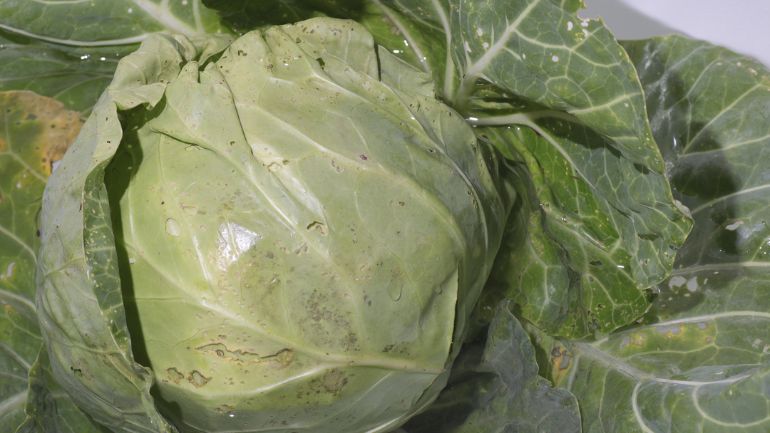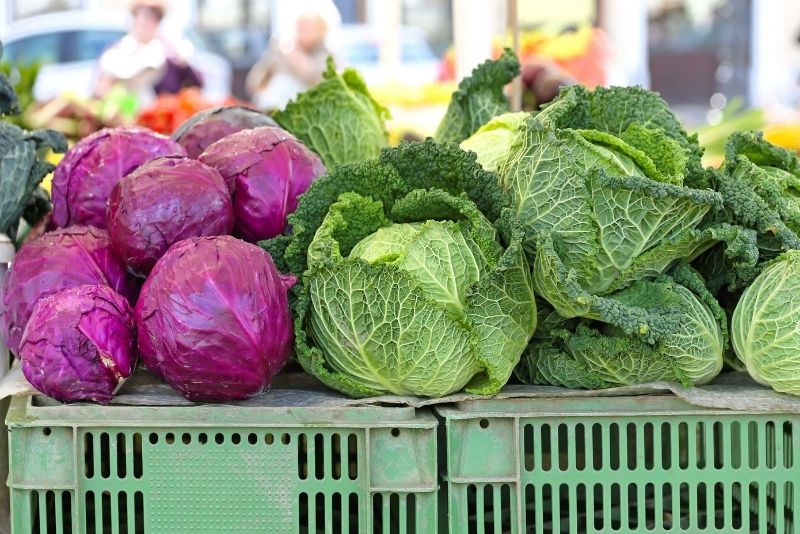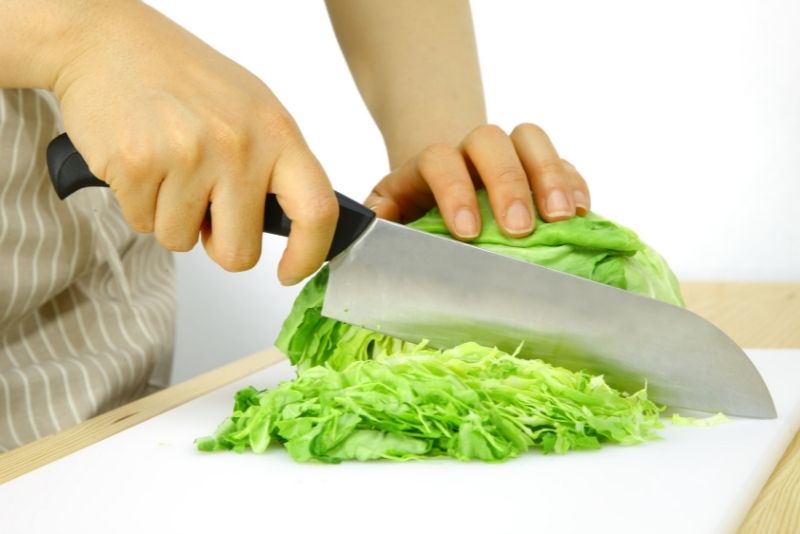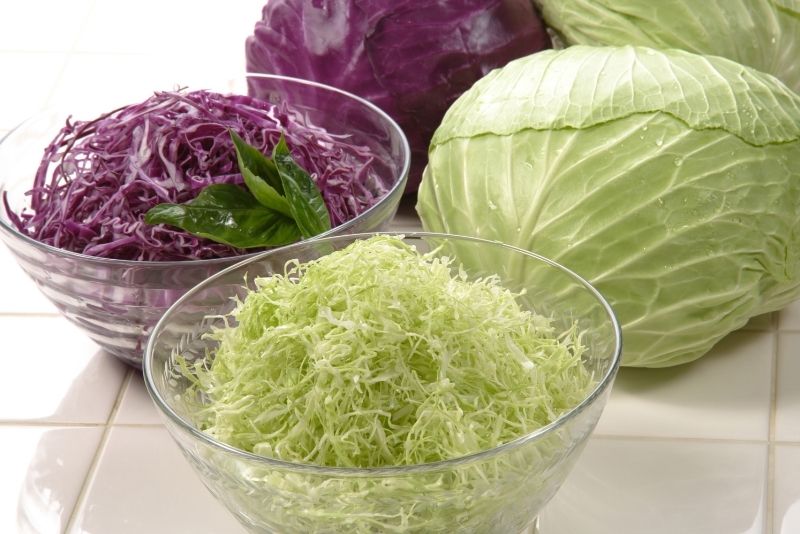Cabbage is a crunchy, nutritious vegetable that can be enjoyed cooked or raw.
But have you ever gone to the grocery store and picked up a head of cabbage only to find that it’s mushy and rotten?
Or maybe you’ve had a head of cabbage in your fridge for a couple of weeks, and you’re not sure if it’s still good to eat.
Like all produce, cabbage has a limited shelf life and will eventually go wrong. But how to tell if cabbage is bad?
To tell if cabbage is bad, check the leaves for brown or wilted spots. If the cabbage looks yellow, it will likely pass its peak freshness. If the cabbage is mushy, has slimy spots or molds growing, or has a sour odor, it is bad, and you should not eat it.

Table of Contents
How to Tell if Cabbage Is Bad?
With this handy guide, you’ll be able to tell if your cabbage is still fresh and edible or if it’s time to make a trip back to the grocery store.
1. Color of cabbage
One of the easiest ways to tell if cabbage is bad is to look at the color. A fresh head of cabbage will have crisp, green leaves. As cabbage starts to go bad, the leaves will begin to yellow and wilt.
If you see any brown or black spots on the leaves, the cabbage has started to rot and should be thrown away.
2. Smell of cabbage
Another way to tell if cabbage has gone bad is to smell it. Fresh cabbage has a crisp, slightly sweet smell. As it starts to go bad, the cabbage will develop a sour smell.
It should not be eaten if the cabbage smells rancid or is like rotting meat.
3. Texture of cabbage
In addition to looking and smelling bad, cabbage that has gone bad will also feel bad. Give the cabbage a gentle squeeze. A fresh head of cabbage will be crisp and firm to the touch.
The cabbage will become limp and mushy as it starts to go bad. If the leaves are wilted, and the cabbage is soft or slimy to the touch, it should be thrown away.
4. Mold on cabbage
Mold is another sign that cabbage has gone bad. Mold can range in color from white to black and appear as spots or patches on the surface of the cabbage.
It should be thrown away if you see any mold on the cabbage.
5. Taste of cabbage
Of course, the best way to tell if cabbage is bad is to taste it. Fresh cabbage should have a slightly sweet, crunchy taste. The cabbage will taste sour and bitter as it starts to go bad. If the cabbage tastes bad, it should not be eaten.
If your cabbage passes all of these tests, it’s safe to eat. Enjoy it in a delicious slaw or sauteed as a side dish. But if not, it’s time to toss it out and get a fresh head of cabbage.
When in doubt, it’s always better to err on caution and throw away cabbage that looks or smells even slightly off.
Cabbage that has gone bad can cause nausea, vomiting, and diarrhea, so it’s not worth taking the risk.
What Happens If You Eat Bad Cabbage?
If you eat bad cabbage, it can cause stomach pain, nausea, vomiting, and diarrhea. It may also lead to more serious foodborne illnesses such as salmonella poisoning. Eating bad cabbage can be dangerous and have lasting effects on your health if not treated quickly.
I’m no health expert, but I know this from personal experience – I once ate a bad batch of coleslaw and ended up with intense stomach pain and diarrhea for days. So, I’d recommend visiting a doctor if you feel any of these symptoms after eating bad cabbage.
To avoid eating spoiled cabbage, ensure the leafy green has no browning or discoloration and keep it refrigerated until cooked.
Ensure to thoroughly cook all types of cabbage before consuming it to kill off any harmful bacteria that might make it unsafe to eat.
What Does Rotten Cabbage Smell Like?
Cabbage contains sulfur compounds that give it a distinct smell, similar to cabbage and onions. When the cabbage has gone bad, you will notice an out-of-place odor stronger than usual – a sign that it’s spoiled and unsafe to consume.
Types Of Cabbage

There are many different types of cabbage, each with its own unique flavor and texture. The most common cabbages you’ll find at the grocery store are green, red, napa, and savoy cabbage.
1. Green Cabbage
Green cabbage is the most common type of cabbage with a light green head and crisp, tender leaves.
It has a slightly sweet, crunchy flavor. It can be eaten raw in salads or cooked in various dishes. It’s often used in slaws and sauteed dishes.
2. Red Cabbage
Red cabbage is similar in appearance to green cabbage but has deep purple leaves. It is slightly sweeter than green cabbage. Red cabbage has a slightly peppery flavor and is often used in salads and stir-fries.
3. Napa Cabbage
Napa cabbage is a type of Chinese cabbage that has long, light green leaves. It has a milder flavor than other varieties of cabbage. Napa cabbage has a slightly sweet flavor and is often used in soups and stir-fries.
4. Savoy Cabbage
Savoy cabbage is another popular cabbage with crinkly leaves and a tender texture. It has a crisp, slightly bitter flavor and is often used in salads and slaws.
How To Cut Cabbage

While it may seem daunting at first, cutting cabbage is quite simple. Just follow these five easy steps.
1. Start by removing the innermost leaves of the cabbage head. These leaves are often yellowed or wilted and can be discarded.
2. Cut the cabbage head in half from top to bottom. If the cabbage is very large, you may need to cut it into quarters.
3. Remove the tough core from the cabbage head’s half (or quarter). The core can be easily identified by its thicker, white stalk.
4. Slice the remaining cabbage into thin strips or chop it into bite-sized pieces, depending on your needs.
5. Give the cabbage a final rinse under cold water, and then it will be ready to use in your recipe.
How To Store Cabbage
Cabbage should be stored in the refrigerator, where it will keep for 1-2 weeks. Once the cabbage has been cut, it should be used within a few days. Proper storage is essential to prolong the shelf life of cabbage.
To extend its shelf life, cabbage can be stored in the freezer for up to 6 months. Simply place it in a freezer-safe bag or container and then thaw it in the refrigerator when ready to use it.
Cabbage can also be pickled, which is a great way to preserve it for long-term storage. Pickled cabbage will keep for several months when stored in the fridge.
When it comes to storing cabbage, the key is to keep it cool and dry. Cabbage stored in a warm, humid environment will spoil more quickly.
Frequently Asked Questions
How do you know if red cabbage is bad?
To tell if red cabbage is bad, check the color of the cabbage. If it starts to turn brown, it is beginning to go bad. The texture of the cabbage may also change, becoming mushy or slimy. If there is any mold growing on the cabbage, it should not be eaten.
If you’re unsure if your red cabbage is still good, smell it. If it smells sour or rotten, it is bad and should be thrown out.
How long does bagged shredded cabbage last?
Bagged shredded cabbage will last about 3 to 5 days in the fridge. If you’ve purchased pre-shredded cabbage, it’s best to use it within a few days for the freshest flavor.
You can extend the shelf life of your cabbage by storing it properly. Keep it in a cool, dry place and tightly sealed in a plastic bag.
Should you wash cabbage?
Washing cabbage is also a good idea if you’re cooking it, as it can remove any dirt or pesticides on the surface.
If you’re using cabbage in a raw dish, like coleslaw, it’s important to wash it first. Cabbage can be contaminated with harmful bacteria that can cause food poisoning. To avoid this, rinse the cabbage under cold water before chopping or shredding it.
What happens when you put salt on cabbage?
Adding salt to cabbage and keeping it for a few minutes will make it wilt. The salt pulls water out of the cabbage leaves, making them limp and wilted. But after you wash off the salt, the cabbage will bounce back and be as crisp as ever.
This is a helpful technique when trying to soften cabbage for cooking. However, if you’re making coleslaw or other raw dishes, you’ll want to avoid adding salt, as it will make the cabbage too soft.
Can you eat cabbage that has turned yellow?
You can eat cabbage that has turned yellow but it will not have the same nutritional value and taste as fresh cabbage.
Final Words
Now that you know how to tell if cabbage is bad and how to store it properly, you can enjoy this healthy vegetable without worry. So go ahead and add some cabbage to your next meal. Your taste buds will thank you.
